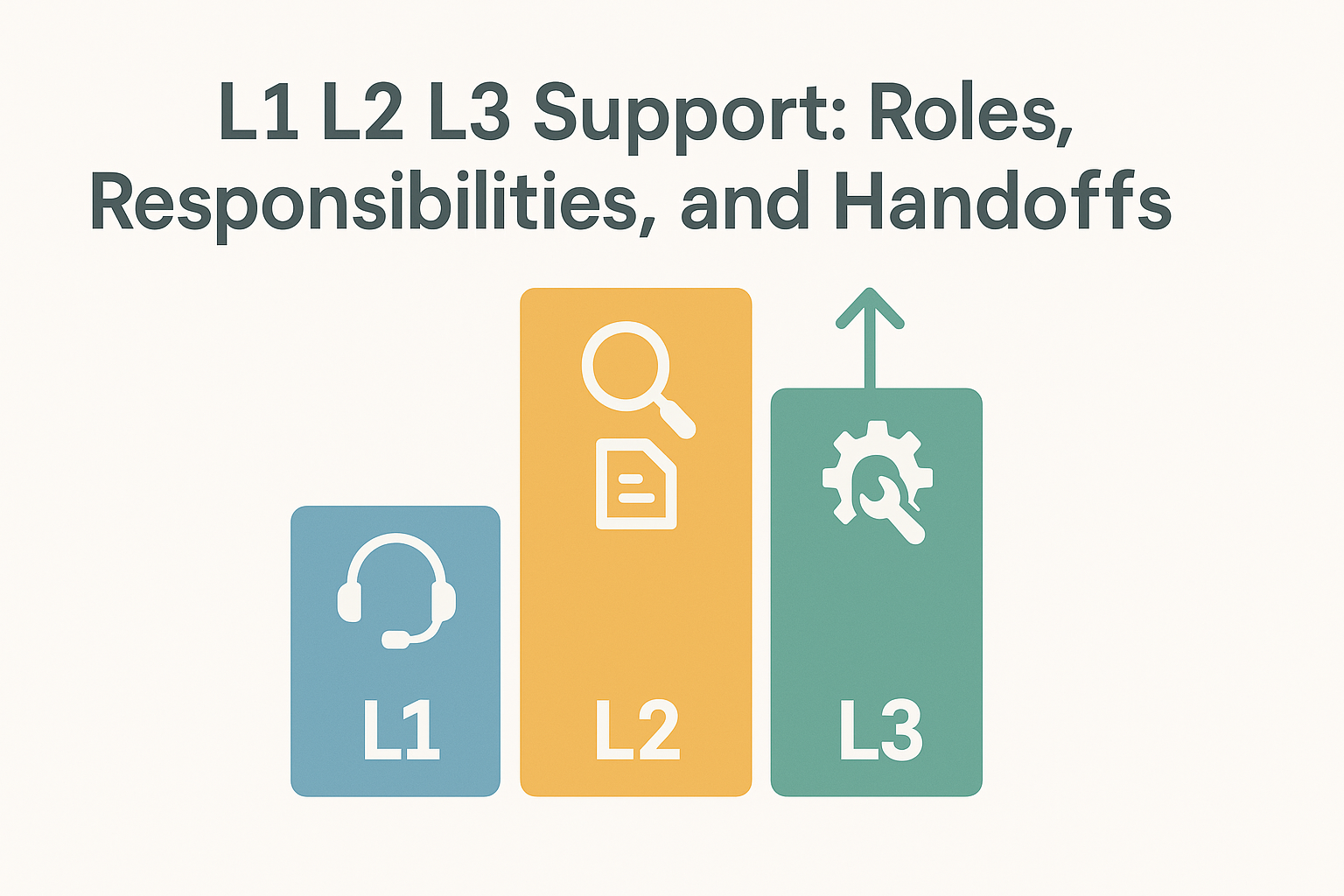Growing teams need clarity more than complexity. A simple L1 L2 L3 support model assigns the right work to the right people, shortens time to resolution, and reduces back-and-forth. In this improved guide, you will get crisp definitions, pragmatic handoff rules, and lean metrics you can ship this week.
A visual ladder of L1, L2, and L3 with who owns what, when to escalate, and how to confirm resolution.
What L1 L2 L3 support means in SaaS
Most support organizations use four layers:
- Level 0: self-service channels such as your knowledge base and status page.
- Level 1: front-line agents who triage and solve common issues.
- Level 2: product specialists who investigate complex cases and coordinate with engineering.
- Level 3: engineers or product owners who ship fixes and long-term mitigations.
Importantly, tiers should reduce friction rather than add bureaucracy. Therefore, start with the fewest levels you can operate well and expand only when data shows a need.
Roles, skills, and tools by tier
Level 1 — fast triage and common fixes
- Handle high-volume questions using saved replies and the knowledge base.
- Confirm impact, capture context, and apply known workarounds.
- Route cleanly when deeper analysis is required.
Helpful tools: quick-apply macros, intent tags, and a tight view for today’s inbox. For language you can paste, see our saved replies for small teams. Additionally, align intake with simple triage so work lands in the right queue; our guide to ticket triage rules shows how.
Level 2 — deep dives and customer-ready updates
- Reproduce issues, check logs, and narrow scope with targeted tests.
- File high-quality bug reports that include steps, expected vs actual results, impact, and customer IDs.
- Send clear updates while L3 investigates so customers are never guessing.
Helpful tools: advanced views, a bug template, and a checklist for “info needed from L1.” Consequently, bounce-backs drop and investigations move faster.
Level 3 — root-cause fixes and prevention
- Own code changes, risky migrations, and systemic mitigations.
- Confirm resolution in production and document prevention steps.
- Publish a short customer-facing follow-up when the dust settles.
Helpful tools: incident channels, feature flags, deploy notes, and a brief post-incident template. In addition, use a lightweight policy for when to escalate; our escalation policy template keeps this simple.
Handoffs that prevent ping-pong
Poor handoffs create loops and frustration. Therefore, standardize these three elements.
- Definition of done at L1: impact captured, steps attempted, screenshots or IDs attached, and a one-line problem statement.
- Escalate with a hypothesis: suspected cause or next test, not “it’s broken.”
- Return path: if L2 or L3 finds a quick fix, send it back to L1 to close the loop and coach future handling.
When to jump levels vs parallel-own
Sometimes you should skip steps. If the customer is blocked and diagnostics will take time, jump straight to L3 while L1 maintains communication. Otherwise, parallel-own: L1 tries a safe workaround while L2 investigates. Finally, keep a single owner for customer updates so messages stay consistent.
Simulate tiers without hiring
Small teams can mirror this model with rotations and views.
- Daily rotations: one person wears the “L2 hat” to handle investigations.
- Shadow queues: a filtered list for suspected bugs so L3 can batch work.
- Office hours: a 30-minute L3 window after standup to unblock L2.
Because responsibilities are explicit, agents gain confidence and customers feel progress sooner.
Metrics that prove your model works
Track a few signals that map to customer outcomes. Moreover, report them weekly so trends are visible.
FCR by tier
Most first-contact resolutions should happen at L1. If L1’s FCR is low while L2’s is high, strengthen front-line replies, add context to intake, or improve your knowledge base. For a simple reporting setup, review our post on helpdesk metrics.
Escalation rate and bounce-backs
Healthy systems escalate only when needed. Therefore, watch the percentage of tickets that move up a level and the portion that bounce back down with fixes. A high bounce-back rate usually signals weak handoff checklists or unclear ownership.
Time to resolution and reopen rate
Measure median resolution time by tier; then check reopens by tier to verify quality. Consequently, patterns reveal where training or templates will help most.
Playbook: implement L1 L2 L3 in 10 days
Day 1–2: design
Draft a one-page tier charter that defines responsibilities, handoff checklists, and the “definition of done” at each level. Next, pick ten intents L1 always owns and five that go straight to L2.
Day 3–5: tools and templates
Create L1 views and routing for those intents. Additionally, add a bug report template and an escalation form with required fields. Set one daily L2 rotation and schedule L3 office hours.
Day 6–8: pilot
Run the model in a single inbox. Meanwhile, hold a daily twenty-minute calibration using five recent tickets to check priorities, handoffs, and tone.
Day 9–10: expand and report
Roll out to the main queue. Finally, publish a short report with FCR, escalation rate, and three example handoffs others can copy.
Calibrate with reputable guides
You do not need to reinvent the model. For context and vocabulary, compare your approach with high-quality vendor explainers that outline support levels and responsibilities:
- BMC: clear overview of support levels and responsibilities
https://www.bmc.com/blogs/it-support-levels-1-2-3/ - Atlassian: support level concepts and when to escalate
https://www.atlassian.com/incident-management/support/escalations - Zendesk: tiered support models in practice
https://www.zendesk.com/blog/support-levels/
Conclusion
Clean L1 L2 L3 support gives your team a calm rhythm: L1 handles the many, L2 solves the tricky, and L3 fixes root causes. Because handoffs are explicit and metrics are visible, customers get clarity and engineers stay focused. Start small, iterate weekly, and keep the playbook light.
Start your free 14 day trial to set up routing, rotations, and simple escalations that match your team’s size and speed.
